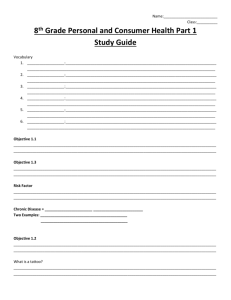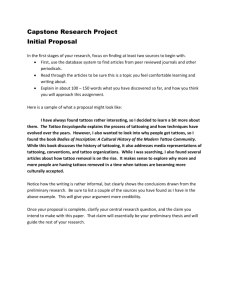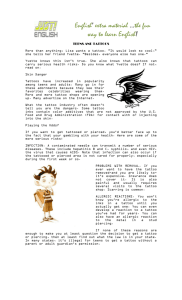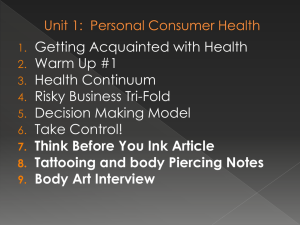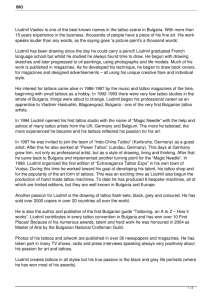Body Art. Tattoos & Piercing
advertisement
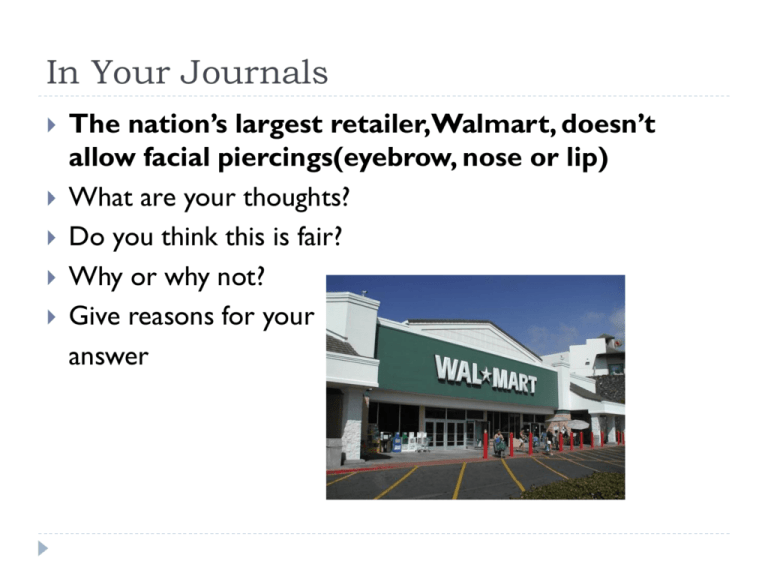
In Your Journals The nation’s largest retailer,Walmart, doesn’t allow facial piercings(eyebrow, nose or lip) What are your thoughts? Do you think this is fair? Why or why not? Give reasons for your answer Body Art. Tattoos&Piercings 9.PCH.2.1 Critique the potential health & social consequences of body art. Today’s Lesson– Essential Questions Identify health consequences of body art Piercings Tattoos Identify social consequences of body art Piercings Tattoos North Carolina Body Art Laws Tattooing Body Piercing Prohibits anyone from tattooing a minor under age 18. Prohibits anyone from piercing any part of a minor under age 18 other than the ears without the prior consent of the custodial parent. Some other states Require prior written consent from parent or legal guardian to tattoo or pierce a minor Global Connection The earliest recorded tattoos were found in Egypt during the time of the construction of the great pyramids When the Egyptians expanded their empire, the art of tattooing spread as well. The civilizations of Crete, Greece, Persia, and Arabia picked up and expanded the art form. Around 2000 BC tattooing spread to China. Tattoos: Understand risks & precautions Tattoos may be more common than ever, but don't take tattooing lightly. Know the risks and understand basic safety precautions and aftercare steps. You could be the owner of a new tattoo in a matter of hours — but don't let the ease of getting tattoos stop you from making a thoughtful decision about permanent body art. If you first take steps to protect yourself from possible risks, what seems like a cool idea now is less likely to turn into a source of regret later. How Tattoos Are Done Tattoo: a permanent mark or design made on your skin with pigments inserted through pricks into the skin's top layer. Typically, the tattoo artist uses a hand-held machine that acts much like a sewing machine, with one or more needles piercing the skin repeatedly. With every puncture, the needles insert tiny ink droplets. What’s the Procedure Like? The tattoo artist will first wash his or her hands with a germicidal soap. The to-be-tattooed area on your body will be cleaned and disinfected. The tattoo artist will put on clean, fresh gloves possibly a surgical mask The tattoo artist will explain the sterilization procedure to you and open up the single-use, sterilized equipment Using the tattoo machine, the tattoo artist will begin drawing an outline of the tattoo under your skin. The Procedure The outline will be cleaned with antiseptic soap and water. Sterile, thicker needles will be installed on the tattoo machine, and the tattoo artist will start shading the design. After cleaning the area again, color will be injected. A new bottle of ink should be opened for each individual. Any blood will be removed by a sterile, disposable cloth or towel. When finished, the area will be cleaned once again and a bandage will be applied. If you’re thinking about it There is one very important thing you have to keep in mind — getting it done safely. Although it might look a whole lot cooler than a big scab, a new tattoo is also a wound. Like any other slice, scrape, puncture, cut, or penetration to your skin, a tattoo is at risk for infections and disease. Plan Ahead—for tattoos & piercing Make sure you're up to date with your immunizations Especially hepatitis and tetanus shots Plan where you’ll get medical care if your tattoo becomes infected Signs of infection Excessive redness Tenderness around the tattoo Prolonged bleeding Pus Changes in skin color around the tattoo Talk To Your Doctor If you have a medical problem Heart Disease Allergies Diabetes Skin Disorders A condition that affects your immune system Infections Or if you are pregnant Ask your doctor if there are any special concerns you should have or precautions you should take beforehand Know The Risks Tattoos breach (break) the skin, which means that skin infections and other complications are possible. Let’s look at some of the risks… Allergic Reactions Tattoo dyes, especially red dye, can cause allergic skin reactions itchy rash at the tattoo site This may occur even years after you get the tattoo. Skin Infections Tattoos can lead to local bacterial infections. Redness Swelling Pain Pus-like drainage Other Skin Problems Sometimes bumps called granulomas form around tattoo ink — especially red ink. Tattooing can also lead to raised areas caused by an overgrowth of scar tissue (keloids) Blood Borne Diseases If the equipment used to create your tattoo is contaminated with infected blood, you can contract various blood borne diseases. Hepatitis B Hepatitis C Tetanus HIV — the virus that causes AIDS MRI Complications Rarely, tattoos or permanent makeup may cause swelling or burning in the affected areas during magnetic resonance imaging (MRI) exams. In some cases — such as when a person with permanent eyeliner has an MRI of the eye — tattoo pigments may interfere with the quality of the image. In Your Journals How do you feel about tattoos? When you see somebody with a lot of tattoos what do you think? Do you have any tattoos? If so, tell us how/why you got them. Was it painful? If not, would you ever consider getting a tattoo? Why/why not? If your 14-year-old son/daughter came to you and said he/she wanted a tattoo/piercing, how would you react? What do you think of tattooed hands? What do you think of tattooed faces? In Your Journals Do you have any piercings? If so, how/why did you got them? How do you react to the following piercings: do you think that they are natural, attractive, weird, or unattractive? Ear Nose Tongue Lip Eyebrow Belly Button Treatment Medication or other treatment may be needed if you develop an allergic reaction, infection or other skin problem. In some cases, the tattoo may need to be removed. Keep in mind that tattoo inks are classified as cosmetics, so they aren't regulated or approved by the Food and Drug Administration (FDA) Insist on Safety Precautions Professional studios usually take pride in their cleanliness. Here are some things to check for… Autoclave Make sure the tattoo studio has an autoclave You should be allowed to watch as equipment is sterilized in the autoclave Instruments and supplies that can't be sterilized with an autoclave a device that uses steam, pressure, and heat for sterilization drawer handles, tables and sinks Should be disinfected with a commercial disinfectant or bleach solution after each use Who Does the Tattooing? Go to a reputable tattooing studio that employs only properly trained employees Check that the tattoo artist is a licensed practitioner If so, the tattoo artist should be able to provide you with references Does the tattoo artist wear gloves? Make sure the tattoo artist washes his or her hands and wears a fresh pair of protective gloves for each procedure. Does the tattoo artist use proper equipment? Make sure the tattoo artist removes a needle and tubes from sealed packages before your procedure begins. Any pigments, trays and containers should be unused as well. No Regret If the studio looks unclean, if anything looks out of the ordinary, or if you feel in any way uncomfortable, find a better place to get your tattoo. Don't get a tattoo if you're under the influence of alcohol or drugs or worry that you might regret the tattoo later. Taking Care of a Tattoo The last step in getting a tattoo is very important — taking care of the tattoo until it fully heals. Follow all of the instructions the studio gives you Call your doctor right away if you see or feel any signs of infection pain, spreading redness, swelling, or drainage of pus To make sure your tattoo heals properly Keep a bandage on the area for up to 24 hours Avoid touching the tattooed area Don't pick at any scabs that may form Wash the tattoo with an antibacterial soap don't use alcohol or peroxide — they'll dry out the tattoo Use a soft towel to dry the tattoo just pat it dry and be sure not to rub it Take Good Care of your Tattoo If you don't have an allergy to antibiotic ointment, rub some into the tattoo. Don't use petroleum jelly (Vaseline) it may cause the tattoo to fade Put an ice pack on the tattooed area if you see any redness or swelling Try not to get the tattoo wet until it fully heals Stay away from pools, hot tubs, or long, hot baths. Keep your tattoo away from the sun until it's fully healed Even after it’s fully healed: A tattoo is more susceptible to the sun's rays Keep it protected from direct sunlight Wear a sunscreen with a SPF of 30 on the tattoo This not only protects your skin, but keeps the tattoo from fading Tattoo Safety Think Before You Ink Social Consequences Consider the negative consequences of tattooing your body for life Although tattoos have become more socially acceptable there are still sections of the general public that look down on tattoos Many tattoo seekers do not realize the negative effects of getting a tattoo in a visible place Stereotypes When you think of someone with a tattoo, what comes to mind? A biker? A sailor? A rebellious teen? These are all stereotypes of tattoos in American culture Getting a Job—Tattoos & Piercing Employers have a say about the acceptability of tattoos and piercing if it is in their dress code They can say no to visible tattoos as long as they are consistent If you have tattoos that can be covered up, you do have a better chance of being hired in corporate America Covering a tattoo for career reasons can be a commitment in its self. This is one reason artists may discourage a tattoo seeker from getting a neck, face, or even a lower arm tattoo. The armed services is also very strict on tattoos being viewable to the public while in the service. Body Piercing A piercing or puncture made in your body by a needle. After that, a piece of jewelry is inserted into the puncture. The most popular pierced body parts seem to be the ears, the nostrils, and the belly button. What to Expect: The area you've chosen to be pierced (except for the tongue) is cleaned with a germicidal soap Your skin is then punctured with a very sharp, clean needle. The piece of jewelry, which has already been sterilized, is attached to the area. The person performing the piercing disposes of the needle in a special container so that there is no risk of the needle or blood touching someone else. What to Expect: The pierced area is cleaned. The person performing the piercing checks and adjusts the jewelry. The person performing the piercing gives you instructions on how to make sure your new piercing heals correctly and what to do if there is a problem. Make sure the piercing shops is clean The person doing the piercing washes his/her hands with a germicidal soap wears fresh disposable gloves uses sterilized instruments does not use a piercing gun (they're not sterile) The needle being used is new and is being used for the first time disposed of in a special sealed container after the piercing Some Health Risks If all goes well, you should be fine after a body piercing except for some temporary symptoms some pain swelling at the pierced area tongue piercing, increased saliva Things can still go wrong chronic infection uncontrollable or prolonged bleeding Scarring hepatitis B and C Tetanus skin allergies to the jewelry that's used abscesses or boils (collections of pus that can form under your skin at the site of the piercing) inflammation or nerve damage Depending on the body part, healing times can take anywhere from a few weeks to more than a year. Don't pick or tug at it Keep the area clean with soap not rubbing alcohol Don't touch it without washing your hands first Never use hydrogen peroxide because it can break down newly formed tissue If you have a mouth piercing, use an alcohol-free, antibacterial mouthwash after eating
